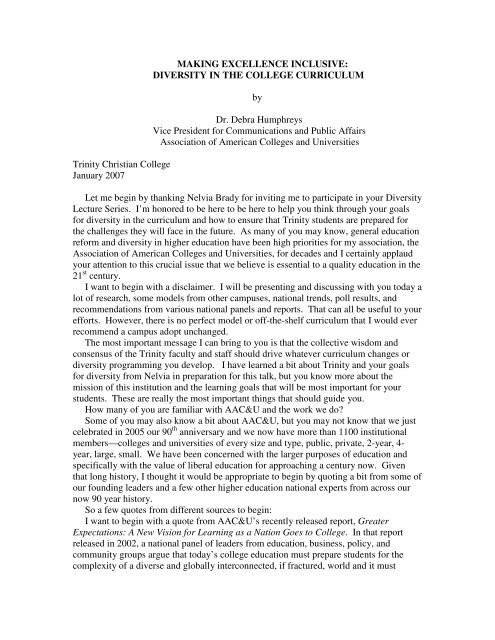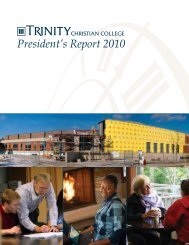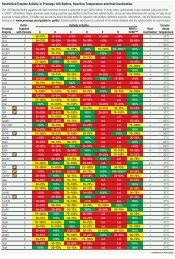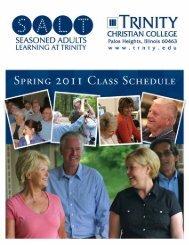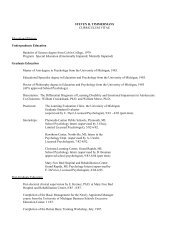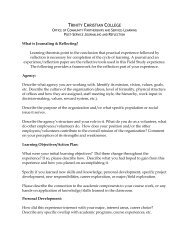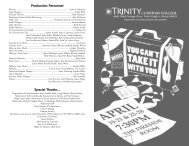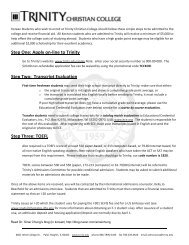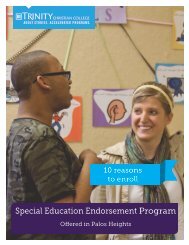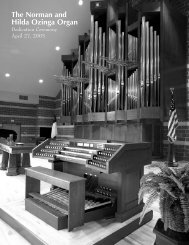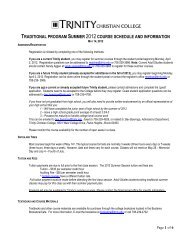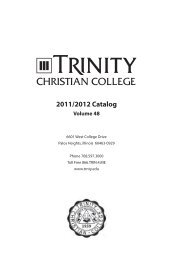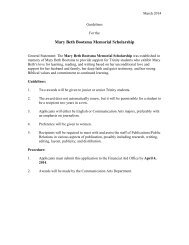address - Trinity Christian College
address - Trinity Christian College
address - Trinity Christian College
You also want an ePaper? Increase the reach of your titles
YUMPU automatically turns print PDFs into web optimized ePapers that Google loves.
<strong>Trinity</strong> <strong>Christian</strong> <strong>College</strong>January 2007MAKING EXCELLENCE INCLUSIVE:DIVERSITY IN THE COLLEGE CURRICULUMbyDr. Debra HumphreysVice President for Communications and Public AffairsAssociation of American <strong>College</strong>s and UniversitiesLet me begin by thanking Nelvia Brady for inviting me to participate in your DiversityLecture Series. I’m honored to be here to be here to help you think through your goalsfor diversity in the curriculum and how to ensure that <strong>Trinity</strong> students are prepared forthe challenges they will face in the future. As many of you may know, general educationreform and diversity in higher education have been high priorities for my association, theAssociation of American <strong>College</strong>s and Universities, for decades and I certainly applaudyour attention to this crucial issue that we believe is essential to a quality education in the21 st century.I want to begin with a disclaimer. I will be presenting and discussing with you today alot of research, some models from other campuses, national trends, poll results, andrecommendations from various national panels and reports. That can all be useful to yourefforts. However, there is no perfect model or off-the-shelf curriculum that I would everrecommend a campus adopt unchanged.The most important message I can bring to you is that the collective wisdom andconsensus of the <strong>Trinity</strong> faculty and staff should drive whatever curriculum changes ordiversity programming you develop. I have learned a bit about <strong>Trinity</strong> and your goalsfor diversity from Nelvia in preparation for this talk, but you know more about themission of this institution and the learning goals that will be most important for yourstudents. These are really the most important things that should guide you.How many of you are familiar with AAC&U and the work we do?Some of you may also know a bit about AAC&U, but you may not know that we justcelebrated in 2005 our 90 th anniversary and we now have more than 1100 institutionalmembers—colleges and universities of every size and type, public, private, 2-year, 4-year, large, small. We have been concerned with the larger purposes of education andspecifically with the value of liberal education for approaching a century now. Giventhat long history, I thought it would be appropriate to begin by quoting a bit from some ofour founding leaders and a few other higher education national experts from across ournow 90 year history.So a few quotes from different sources to begin:I want to begin with a quote from AAC&U’s recently released report, GreaterExpectations: A New Vision for Learning as a Nation Goes to <strong>College</strong>. In that reportreleased in 2002, a national panel of leaders from education, business, policy, andcommunity groups argue that today’s college education must prepare students for thecomplexity of a diverse and globally interconnected, if fractured, world and it must
prepare students who are self-directed and intentional about their own educationalcareers. That report argues that in an education that prepares students to be “intentionalleaners” “intellectual study connects to personal life, formal education to work, andknowledge to social responsibility. Through understanding the power and implications ofeducation, intentional learners consciously choose to act in ethical and responsible ways.Able to place themselves in the context of a diverse world, these learners draw ondifference and commonality to produce a deeper experience of community.”The Greater Expectations national panel also recommends that all college studentstoday learn the values and histories underlying US democracy, the interrelations withinand among global and cross-cultural communities, skills in intercultural communication,understanding of one’s self and one’s multiple identities, and respect for the complexidentities of others, their histories and their cultures.We found it interesting, if a bit startling to juxtapose this contemporary rhetoric aboutthe role of diversity in the curriculum today with excerpts from the opening <strong>address</strong> byRobert Kelly at AAC&U’s first meeting in 1915. Kelly was president of Earlham<strong>College</strong> and AAC&U’s first president. In arguing for why a national organization ofAmerican colleges devoted to liberal education was needed, he says,“Many of our citizens are of German, Italian, and Bohemian descent. We have withinthe limits of our country Puritans, Knickerbockers, Cavaliers, Cowboys, and Hoosiers.We have among us Hebrews and Catholics, Mormons, Mohammadans and Methodists.We have Republicans, Democrats and Socialists. We have indeed a great conglomerationof citizenship, from one point of view; but above all and beyond all we have Americancitizens. There is such a thing as an American spirit, as the soul of America.”So, while Kelly’s remarks (and especially the language and vocabulary he uses) aredistinctly of his era—1915—they do reveal this concern about diversity from the verybeginnings of our association. They also reveal that diversity means different things todifferent people and in different contexts. For instance, you’ll note that religion,ethnicity, and geography are key diversity issues for Kelley. As I talk to educationalleaders around the country today, I would venture to say that most of us tend to think firstof race and possibly gender when we hear the word diversity. After some reflection,however, most would also agree that religion, ethnicity and geography remain extremelyimportant elements of identity in today’s society. So, we need to keep in mind thatdiversity means different things to different people in different contexts. I often hear frompeople on many campuses—and I heard it from some of you in preparing for thissymposium—that “our campus lacks diversity.” And what those who say that usuallymean is that our campus isn’t very racially diverse. But remember that not all elementsof diversity that influence our identities and how we are treated in our society—and thatcan be used to advance educational goals—are visible on the surface.And, however one defines the word diversity, I put before you three overridingquestions that I think every college campus needs to grapple with.How exactly are we to really achieve meaningful inclusion in this era of GreaterExpectations?Why is diversity important in higher education in this context—and in your and yourstudents’ own local, national, and international contexts?
And, finally, what impact does diversity really have on achievement of your ownlearning goals?I have titled my talks this morning Making Excellence Inclusive and I mean by thatphrase two things. On the one hand, many of us believe that the academy needs not onlyto increase access to higher education and the diversity of our campuses, but also ensurethat all students receive the very best education we can give them. We must ensure eventraditionally underrepresented students both access and success in achieving key learninggoals important in today’s world.On the other hand, we also need to change our notions of excellence to be sure that allstudents, whatever their background or prior learning, learn about issues of diversity, andpreferably in diverse settings. If we don’t do this, we are doing a disservice to all ourstudents. And I will be talking a bit this morning about the compelling evidence aboutthe positive educational impact of diversity on a host of key learning outcomes for allstudents.So, however we define it, diversity, and, in fact, the reform of general education havebeen enduring themes in higher education. This is perfectly appropriate. For, as a 1977document from the Carnegie Foundation for the Advancement of Teaching put it, “Thecurriculum is the major statement any institution makes about itself, about what it cancontribute to the intellectual development of students, about what it thinks is important inits teaching service to society.”And to quote Fred Rudolph, that eminent historian of education, in the same year(1977), “Values change, and so does the curriculum, as the more than 300 years since thefounding of Harvard <strong>College</strong> clearly say. Since that time, long ago, when a peculiarlyself-demanding band of alienated Englishmen got themselves a college almost beforethey had built themselves a privy, change in the course of study has been constant,conscious and unconscious, gradual and sudden, accidental and intentional, uneven anddiverse, imaginative and pedestrian.”So, this is an ongoing conversation nationally. And here and nationally, it won’t endthis morning here at <strong>Trinity</strong> and I am well aware that it didn’t begin this morning eitherhere or elsewhere.So, to set our discussion in a national context, what are the changes in the generaleducation curriculum that characterize our current era of reform? What are the nationaltrends?And before I start my slides, I want to say that I have summarized a lot of research invery few words on these slides so I have included in your handouts a list of all mysources for all these various things. Some of these sources are identified on the slides,some findings I’m presenting emerge from so many different studies, I just didn’t haveroom to list all the studies. If there is a particular finding that you are interested in, I cancertainly find you the specific studies either today or when I go back to DC. So, all thestudies to which I refer are included in the bibliography on the last pages of the handouts.In 2000, AAC&U did a number of surveys of our members and of higher educationinstitutions generally and I’m going to do a very quick tour of what we have found aboutthe priorities of colleges and universities in terms of general education reform, anddiversity in the curriculum. I, then, will present some highlights of what research istelling us about what difference diversity makes in terms of actual student learning
outcomes—that information will be based on a number of studies done by researchersaround the country, not necessarily by AAC&U alone.So, first slidesBefore I summarize the educational research on the impact all these curriculumchange and other diversity efforts are having on student learning, I want to share with youa chart for mapping out campus diversity. This chart was developed by Daryl Smith fora book she wrote for AAC&U called Diversity Works: The Emerging Picture of HowStudents Benefit. I think this schema is particularly useful in several ways: 1) itindicates that campus diversity means different things to different people depending ontheir jobs and location on campus, (give examples—admissions, faculty, departmentchair) but also 2) that understanding what diversity means in higher education requires usto look at some very different areas of the academy and sources of data and how theyinterconnect. The most important part of the chart are the arrows representing theinterconnections.One of the most important findings in the research is that those institutions that have aholistic plan and visible leadership and commitment to <strong>address</strong>ing issues of diversityseem to have better intergroup relations and diversity outcomes by a variety of measures.So making the connections among one’s various diversity programs—including cocurricularefforts—can have a big impact. For instance, using this chart as a guide, wemight ask ourselves what specifically is the relationship between our success at recruitingand retaining a more diverse student body and our efforts to encourage intergroupdialogue on campus, to create an environment free of discrimination against minoritystudents? So, recruitment is related to climate. What is the relation between our effortsto diversify our faculty and diversity in our curriculum? In what ways do the leaders ofour institution and the founding documents that describe the institution to the outsideworld reflect a clear commitment to the value of diversity?So, let me conclude by quoting a statement AAC&U’s board of directors passed a fewyears ago on Affirmative Action, Educational Excellence, and the Civic Mission ofHigher Education. In part, this statement observes that: “higher education can do its bestwork when it embraces the diversity of ideas and experiences that characterize the social,cultural, and intellectual world….Persuasive research indicates that for all students,engaging diversity on campus and in the curriculum promotes intellectual development,enhances critical thinking, reduces prejudice, improves intergroup relations, andcontributes to student academic success and satisfaction. Exploring diversity alsoproduces graduates more likely to engage as informed citizens in remedying unsolvedsocial problems.”Thank you very much for your time and attention.


